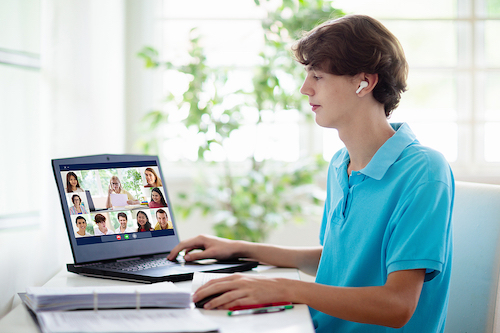 Teenagers experienced less anxiety and felt more connection to school during lock down due to the COVID-19 pandemic.
Teenagers experienced less anxiety and felt more connection to school during lock down due to the COVID-19 pandemic.
A study from the University of Bristol examined how 1000 teenagers across 17 schools in the South West of England coped during lockdown when they weren’t attending school in person.
The students involved in the research were first surveyed in October of 2019, prior to the pandemic, as part of a wider piece of research into social media use and mental health and wellbeing in teens. In October, more than half (54 per cent) of 13-14 year old girls who did the survey showed signs they were at risk of anxiety, while 26 per cent of boys in the same age range showed signs they were at risk.
When the survey was repeated in May of 2020, during the COVID-19 pandemic which saw schools in the UK shut, the percentage of teens who were at risk of anxiety dropped by almost 10 per cent among girls to 45 per cent and dropped to just 18 per cent of boys.
The study authors had expected to see an increase in anxiety due to the pandemic, and were surprised by what they found.
“Due to the pandemic, resultant lockdown and school closures, it was really important to understand how young people had been affected by these changes. The study provided a unique insight into how many younger teenagers feel without the day-to-day pressures of school life,” Emily Widnall, lead author of the study and Senior Research Associate in Population Health Sciences at the University of Bristol's Medical School told Theravive.
“Overall we found reductions in anxiety and rises in wellbeing but no large changes in depression in the majority of students. We saw larger improvements in mental health and wellbeing for students who had poor mental health and wellbeing before lockdown. Students with low school, peer and family connectedness pre-pandemic, saw the biggest improvements in mental health and wellbeing during lockdown. Students’ school connectedness also increased overall for both girls and boys, indicating that some of the measures put in place by schools during lockdown were successful at nurturing connectedness,” she said.
Boys were found to have a greater improvement in sense of well-being than girls. The students who had the lowest level of wellbeing prior to the pandemic saw the greatest benefit during lockdown, with their wellbeing scores increasing by 14 per cent.
The results of the study raise questions around the impact the school environment can have on the mental health of teenagers. Widnall says the findings shine a light on how younger teens may feel without the daily pressures they have at school like difficult peer relationships or academic pressures.
“Improvements in mental health and wellbeing may be due to the removal of stressors within the school environment, such as pressure of academic work, and challenging peer relationships. This study raises questions about the role of the school environment and its impact on teenage mental health,” she said.
Although the students surveyed didn’t attend school in person due to lockdown, both girls and boys said they felt a stronger connectedness to their school during this time. There were also significant increases in the number of teens who reported having opportunities to talk to their teachers.
Widnall says further research will be important to explore why young people felt more connected to their school during lockdown. One possible explanation is the use of digital platforms to engage with students.
The reduction in anxiety and improvement in well-being experienced by the students surveyed also coincided with notably greater usage of social media among girls. During lock down, 55 per cent of the girls surveyed said they spent more than three hours every day on social media.
Widnall argues this challenges the commonly held view that social media has a negative impact on the mental health of young people. She says her findings suggest that social media can help teenagers feel connected with others during a period when they are physically isolated.
Based on the findings of the study, Widnall says that when schools return to face to face learning, it will be important to address how the school environment can impact the mental health of students.
“I think our take home message from this research would be the importance of the school environment on teenage mental health and wellbeing and how we can support schools to make school culture more supportive of mental health,” she said.
“As schools fully reopen students’ mental health and wellbeing may have to be prioritised before catch up on academic work can be achieved. Our findings also reemphasise the need for more investment in resources for mental health support in schools.”
Elizabeth Pratt is a medical journalist and producer. Her work has appeared on Healthline, The Huffington Post, Fox News, The Australian Broadcasting Corporation, The Sydney Morning Herald, News.com.au, Escape, The Cusp and Skyscanner. You can read more of her articles here. Or learn more about Elizabeth and contact her via her LinkedIn and Twitter profiles.